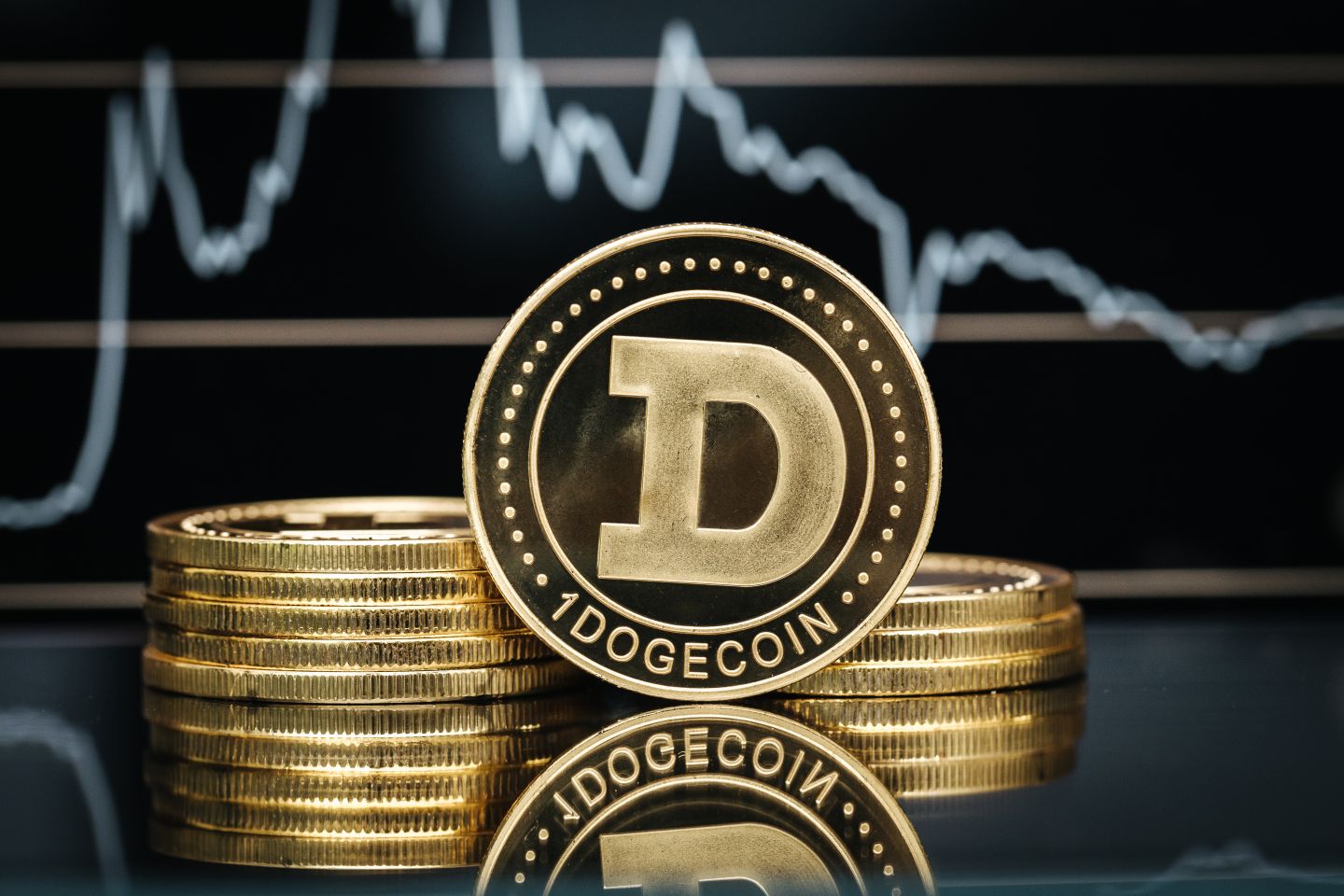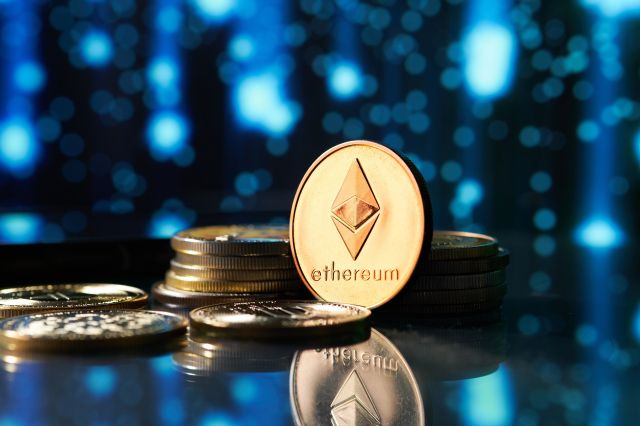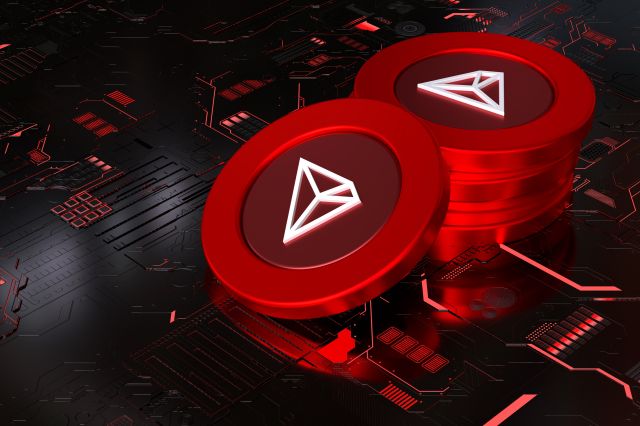How to trade Dogecoin

Learn all about dogecoin with its price history, who owns the most dogecoin, and how to trade DOGE/USD via CFDs
What is dogecoin?
Dogecoin (DOGE) is a decentralised, peer-to-peer cryptocurrency that operates on its own purpose-built blockchain, developed as a fork of litecoin. It’s often considered an ‘altcoin’ – a term for cryptocurrencies other than bitcoin – and it consistently ranks among the top 10 cryptocurrencies by market capitalisation on platforms like CoinMarketCap.
Created in December 2013 by software engineers Billy Markus and Jackson Palmer as a lighthearted satire of the burgeoning cryptocurrency market, dogecoin features a distinctive Shiba Inu dog, inspired by the ‘doge’ meme.
Dogecoin has an unlimited token supply. Over 10,000 new coins are mined every minute, which helps to control price volatility, lower transaction fees and maintain fast network speeds. Its low fees and friendly community contribute to its popularity as a means to tip content creators on social media platforms such as X (formerly Twitter) and Reddit, as well as for charitable fundraising initiatives such as Doge4Water.
Elon Musk – the CEO of Tesla and SpaceX, and owner of X (formerly Twitter) – has played a significant role in dogecoin's popularity, as his public endorsements have often led to substantial price movements.
Dogecoin vs bitcoin
|
Dogecoin (DOGE)Bi |
Bitcoin (BTC) |
|
|
Launch year |
2013 |
2009 |
|
Creator(s) |
Billy Markus & Jackson Palmer |
Satoshi Nakamoto |
|
Supply limit |
Unlimited |
21 million coins |
|
Algorithm |
Scrypt |
SHA-256 |
|
Block time |
~1 minute |
~10 minutes |
|
Transaction fees |
Low |
Higher |
|
Market Cap rank |
Often in top 10 |
#1 |
|
Primary use |
Tipping, microtransactions, charity |
Store of value, digital gold |
Who owns the most dogecoin?
Dogecoin’s blockchain is transparent: anyone can view wallet addresses and transaction histories, but the identities behind these addresses remain anonymous.
As of October 2024, approximately 21.73% – more than a fifth – of the total dogecoin supply is held in a single dogecoin wallet. This amounts to more than 31 billion dogecoin with a value equivalent to billions of dollars, depending on the current price.
The next largest wallet holds around 6.8% of the total supply and the top 100 wallets hold a substantial percentage of dogecoin, which indicates a high level of concentration among large holders, often referred to as ‘whales’.
Will dogecoin ever reach $1?
Dogecoin’s all-time high was at approximately $0.74, reached in May 2021. Whether or not it’ll reach $1 depends on several factors.
What factors could support Dogecoin’s potential rise to $1?
-
Increased adoption and wider acceptance of dogecoin for payments and transactions could boost demand.
-
Community growth, a growing user base, and increased engagement may boost market sentiment.
-
Influencer endorsements and continued support from influential figures like Elon Musk can stimulate price increases.
-
Market trends and bullish sentiment in the broader cryptocurrency market often lifts altcoins like dogecoin.
What factors could challenge Dogecoin’s potential rise to $1?
-
Unlimited supply and the continuous mining of new coins into circulation requires ever-increasing demand to sustain price growth.
-
Market competition and the emergence of new cryptocurrencies with advanced technologies might divert attention away from dogecoin.
Regulatory hurdles including potential regulations targeting cryptocurrencies could impact market dynamics.
What is dogecoin’s price history?
Dogecoin quickly gained a following after launching, along with significant volatility.
In the three days ending December 19, 2013, dogecoin increased by nearly 300%. Shortly after, it experienced its first major crash when China announced a ban on its banks from investing in cryptocurrencies, in an example of how dogecoin is susceptible to broader market events.
Dogecoin was listed on several major exchanges in early 2014, increasing accessibility for traders. Later that year, dogecoin's trading volume briefly surpassed that of bitcoin and all other cryptocurrencies combined, highlighting its growing popularity. Dogecoin maintained a loyal following between 2014 and 2020. During this time, it was regularly used for tipping and microtransactions on social media platforms and various fundraising efforts, boosting its visibility and user base.
A surge in popularity
In early 2021, dogecoin experienced a significant surge in price and popularity. In January, the price increased over 800% in 24 hours, influenced by attention from Reddit users and Elon Musk's tweets during the GameStop short squeeze. By May 2021, dogecoin reached an all-time high of approximately $0.74, coinciding with Musk's appearance on "Saturday Night Live."
Following the 2021 peak, dogecoin experienced significant volatility, with prices declining alongside the broader cryptocurrency market. The downturn in 2022, influenced by global economic uncertainties and regulatory concerns, affected dogecoin's price. However, it remains one of the top cryptocurrencies by market capitalisation.
In April 2023, Elon Musk temporarily changed Twitter's logo to the Doge meme, causing a brief price spike. Such events highlight the ongoing influence of social media and celebrity endorsements on dogecoin's price movements.
Dogecoin price chart
What factors might affect the dogecoin live price?
Dogecoin's price is influenced by a combination of factors, including market sentiment, technological developments, and external events.
Elon Musk’s endorsements, such as his tweets and public comments moved the market on multiple occasions – often causing dramatic price surges. For instance, Musk’s tweets in early 2021 helped drive dogecoin’s rise to its all-time high. This can go either way, as negative or unclear statements from Musk may lead to price drops.
Cryptocurrency market activity – dogecoin’s live price often moves in tandem with broader trends in the cryptocurrency market. When the overall market sentiment is bullish, particularly when major cryptocurrencies like bitcoin see price gains, dogecoin often follows suit. Conversely, in bearish conditions, dogecoin may experience downward pressure. Broader trends, such as regulatory changes or technological advancements within the crypto ecosystem, can also influence Dogecoin’s price.
Large wallet concentration – the concentration of dogecoin in a few large wallets can lead to increased market volatility. If one of these large holders decides to sell a significant portion of their holdings, it could cause a sharp decrease in the price due to the sudden increase in supply. Conversely, large purchases by these holders can lead to sudden, unexpected price rises. This concentration underscores the importance of monitoring whale activity when trading dogecoin.
Network developments and technological updates – improvements to dogecoin's blockchain, such as increased transaction speeds or security enhancements, can boost investor confidence and demand. Technological partnerships or integration with other platforms can also positively affect the price. Conversely, the emergence of more advanced competitors or a failure to keep up may divert market demand away from dogecoin, potentially leading to a price decrease.
Media coverage and public perception – positive coverage, including celebrity endorsements or viral social media campaigns, can drive new interest and attract retail investors, leading to price spikes. Conversely, negative reports, such as regulatory crackdowns, exchange hacks, or broader scepticism about cryptocurrencies can quickly erode confidence, influencing price decreases.
What are the dogecoin trading hours?
Dogecoin operates on a decentralised blockchain network that is active 24 hours a day, seven days a week. This means you can trade dogecoin at any time, including weekends and holidays.
-
Cryptocurrency exchanges – many exchanges facilitate 24/7 trading, allowing for continuous market participation.
-
Online trading platforms – some reliable and trusted brokerages provide dogecoin trading via CFDs with extended hours.
If you choose to trade CFDs, you can follow the DOGE/USD performance live in US dollars with our comprehensive DOGE/USD price chart.
Monitoring the cryptocurrency’s activity can help you to keep an eye out for any key fundamental or technical events that may affect short-term movements in its value.
How to trade dogecoin
Dogecoin is a cryptocurrency, meaning that it can be traded directly on a cryptocurrency exchange or peer-to-peer. Traders may also choose to trade dogecoin via a derivative, a financial product that takes (or ‘derives’) its value from the price of the underlying asset.
You could use a contract for difference, or CFD, to trade on the DOGE/USD price. A CFD is a contract, typically between a broker and a trader, where one party agrees to pay the other the difference in the value of a security, between the opening and closing of the trade.
With CFDs, you can take a position on the DOGE/USD price rising (called ‘going long’) or falling (‘going short’). CFDs give you access to leverage, allowing larger positions with a relatively small outlay. This amplifies your potential profits, but also your potential losses, making CFD trading risky.
You can learn more about trading cryptocurrencies with Capital.com in our comprehensive guide to cryptocurrency trading.
Aside from CFDs, you can also trade dogecoin through instruments like futures, options, ETFs, and mutual funds. Each offers an alternative to the leveraged trading of CFDs, suiting different risk profiles and investment strategies.
FAQs
What is dogecoin?
Dogecoin is a decentralised cryptocurrency that has a Shiba Inu dog inspired by the ‘Doge’ meme as its mascot. Created in 2013 by Billy Markus and Jackson Palmer, it started as a joke but has evolved into a widely used digital currency for tipping, charitable donations and microtransactions.
How do I trade dogecoin?
You can trade dogecoin by purchasing it on cryptocurrency exchanges or by trading financial derivatives like CFDs on platforms such as Capital.com. CFDs allow you to speculate on price movements without owning the actual cryptocurrency.
Will dogecoin reach $1?
While dogecoin reached an all-time high of approximately $0.74 back in May 2021, whether or not it will reach $1 depends on factors like market demand, adoption rates and broader cryptocurrency market trends.
Do I need a crypto wallet to trade dogecoin?
If you're buying actual dogecoin on an exchange, you'll need a digital wallet to store your coins securely. However, if you're trading CFDs on platforms like Capital.com, you don't need a wallet since you're not purchasing the underlying asset.
Visit our other complete guides

How to trade Ethereum
